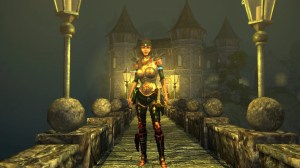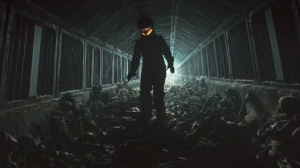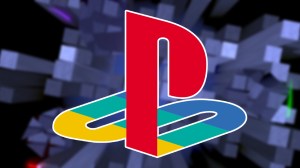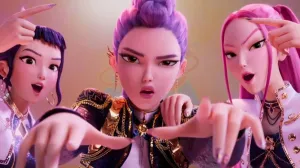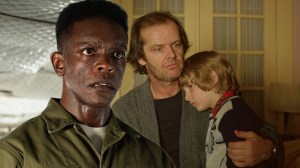The Snowpiercer TV series is nearing the halfway point of its first season, and it’s giving audiences a pretty unique form of escapism in the process. The TNT original series has sought out to adapt the 1982 French graphic novel Le Transperceneige, which was adapted into a cult classic film by Bong Joon-Ho in 2014. Set in a post-apocalyptic frozen wasteland, the series follows the remainders of humanity on a gigantic, globe-trotting train who have sorted themselves into various classes. When a murder mystery begins to plague the upper classes of the train, Andre Layton (Daveed Diggs), a passenger in the “Tail” end of the train, and Melanie Cavill (Jennifer Connelly), the head of hospitality, are forced to work together — and just might upend the status quo of the train in the process.
Videos by ComicBook.com
The series, which has already been renewed for a second season, takes the general concept of the franchise to surprising new heights, with the help of a talented ensemble working in front of and behind the screen. This includes Barry Robison, an award-winning production designer whose filmography includes Hacksaw Ridge, X-Men Origins: Wolverine, and The Chronicles of Narnia: The Voyage of the Dawn Treader. While Robison has dabbled in television before with episodes of Good Girls and They Came From Outer Space, Season 1 of Snowpiercer marked his largest foray into the medium yet — and It’s safe to say that he made a pretty profound impact.
ComicBook.com got to chat with Robison about his work on the first season of Snowpiercer, and the challenges and blessings of designing for such a confined setting. We also spoke about his work on Amazon’s now-canceled TV adaptation of The Dark Tower.

Joining Snowpiercer
ComicBook.com; How did you get involved with Snowpiercer? Were you familiar with either the movie or the graphic novel at all?
Barry Robison: I was. I’ve seen the movie. loved it, so I’d seen it a couple of times. I got a call from my agents out of the blue, and they said there was a project in Vancouver and that they needed a strong designer immediately. I said, “What is it?” They said “Snowpiercer.” and I said “Oh, wow.” I loved that idea. I’d never done a long-form television before, because most of my work has been feature films.
I was a little nervous about it. I read the bible for the first five episodes and I loved it. And then I had a Skype meeting with the creatives, Graeme [Manson] and James Hawes, TNT, and Tomorrow Studios, and it went really well. The next thing I knew, I was on a flight to Vancouver and hit the ground running.
Creating Something New

Since you were a fan of the movie, how did you approach the balance of homaging what it did, in terms of production design, without copying it?
We had a big conference call with the studio, with TNT and the creatives, and they started asking me questions just like you are. I said, “Listen, I don’t want this to be a copycat of the movie. We’ve got the ability to really expand on the visual dialogue and visual language that the movie set forward.” TNT and Graeme were particularly interested in not being a copycat [of the movie]. They really wanted the show to have its own identity. I was thrilled when they said that. I was just so excited.
What I did, rather than look at the movie and take my cues from the movie, I suggested that we go back to the graphic novel. The design of the graphic novel, and the elements of it, are so strong and so great. Even though they’re black and white illustrations – or sometimes a shot of blue – I was really able to reinterpret the designs of the graphic novel and then make them my own. And then, as the series progressed and storylines were developed, we got to introduce cars that had never been seen.
The Classes
One thing I loved watching Season 1 is how the visuals are used to convey the different classes of the train. What design elements did you consider to be a priority, when it came to that?
To me, I would say that it was light that was the overriding influence between the classes. If you’re in the Tail section, that is a window list sort of dark, gulag environment. As you move up the train between the classes, I introduced windows and the light. So nothing in the Tail, small utilitarian windows in Third Class, larger windows in Second. By the time you get up to the First Class, there are large windows, big picture windows, looking out onto the frozen landscape.
For me, it sort of could represent poverty, lower class, middle class, and then the upper class. And if you want, you could also say that by the time you get to the First Class, it’s somewhat of a representation of heaven, because all of the materials are pale and light. Whereas you go down the train and they’re rougher and more robust, and when you finally get into the Tail section. You’re into steel and grit and grime.
The Night Car

The Night Car was so visually interesting to me, because it almost does not feel like it’s in the confined space of a train. What was the design process going into that set in particular?
We were on four sound stages in Vancouver, and every car was built on a modified tractor-trailer. None of the cars are wider than twelve feet, and the longest car we were able to have was 60 feet long. The Night Car is twelve feet wide and 45 feet long, and there’s a trick in it that creates the illusion of it being a larger space. If you look at the design, there are these circular curtain areas that are based on a 19th century Viennese design, where when the curtains are closed, anything can happen behind that curtain, whether it’s illicit sex or drugs or conversation.
So we can really close the space down tighter, or we can open it up. It was interesting, designing within the constraints of 12 feet wide and 40 feet long. It was really a challenge, and one that I really loved, because the studio never wanted the set to be boring. They always wanted it to be surprising in some ways. And for me, the Night Car really exemplified that. It could open and shut and it really worked well.
Surprises
What surprised you the most in working on Snowpiercer?
I haven’t really thought about that. There are so many elements, to be honest with you. One, right off the bat, working with a group of collaborators like Tomorrow Studios, TNT, and then the creatives, the showrunners and directors. To me, that was fantastic, because basically anything can happen. Anyone can bring an idea to the table and it’s not discounted, it’s just looked at and analyzed and then reacted to. For example, I was really thrilled that I could bring a design and pitch it, and it was either bought or sold.
One, in particular, that was really interesting to me was a set called The Chain. I had talked to James and it wasn’t clearly defined space in the bible or in the scripts, and we were getting close to needing it, and the studio was wanting to know what was going on with that. I suggested to Graeme and James that the train is 1000 and more cars long, 10 miles, and there had to be basically dry goods and food cars that were being used, and then emptied and not being replenished. I suggested, rather than just taking one of our standard cars, we would take one of these container cars. And the young people that wanted to create their own space and be creative would be able to do that in the containers, by sort of cutting them up, making ladders. Rather than being totally on top of one another, you could have your own individualized space.
Everybody loved that idea, but it was a hard sell for me. I had to do a lot of renderings. I had to do models. I had my fantastic construction crew up in Vancouver and the metal shop build a full-scale model so that everybody could get behind it and scan the concept. That, to me, was really exciting. It was really different than a feature film, way different.
Favorites

Is there a part of the production design that was your favorite?
I love the Night Car. There’s no question about that. It speaks a lot of my theatrical bend. I love the First Class dining car. That was a really hard set to pull off, because the finishes had to be so high end. And I love parts of the Tail. Those would be some of my favorites.
The Dark Tower
I heard through the grapevine that you also worked on Amazon’s recent The Dark Tower adaptation. Can you speak about that at all?
I got to tell you, I loved it. I got a call from the agent, and they said “Amazon’s going to do a television adaptation of The Dark Tower.” And I went, “You’re kidding!” I wasn’t familiar with the feature, but I was familiar with the novels, because I like Stephen King and I like his writing. I hadn’t read them in a long time. I read [the script], I met with the showrunner and producer, and I was hired. And then we flew to Croatia, where the production was going to be based out of, and I started doing that on my own. I didn’t have a director to answer to, so it was the producers and myself putting that show together visually, and that was really super exciting. I loved that.
While we were prepping and shooting, Snowpiercer was picked up for a second season and I couldn’t do it. I was sort of gutted, as they say, because I really felt that I had so much more to give Snowpiercer, and I just loved that world. Sadly, we finished on The Dark Tower pilot, and then Amazon didn’t pick it up, so lose-lose.
Hopefully, we get to see it in some capacity, because I’m really excited about it, and knowing how passionate you are about it definitely adds to that.
Let me tell you, you’ll freak out when you see it. It’s so good.
***
Snowpiercer airs Sundays at 9/8c on TNT.

